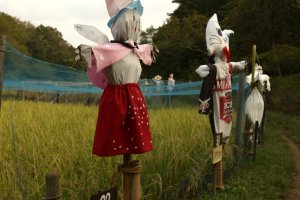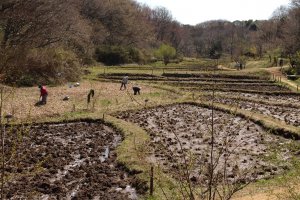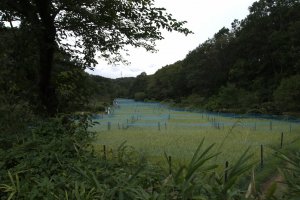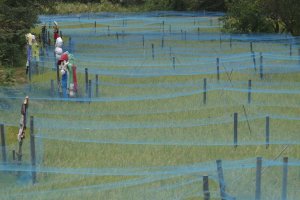The first time I walked on the banks of the rice fields of Maioka Park more than a decade ago, I exclaimed to myself: “This is an oasis in the concrete desert of Yokohama!” This feeling was further intensified when a few days later I was standing on the 69th floor of the Landmark Tower in Sakuragicho filming the panoramic view of Yokohama City. I couldn't see anything buy grey buildings and grey sky.
But like a hidden treasure, the 72 acre satoyama village of rolling woodlands and rice paddies that is Maioka Park was just over there, beyond the skyscrapers, waiting to be discovered. From Totsuka Station, it only takes about fifteen minutes by bus. Or from Maioka Station on the Blue Line, it’s only a fifteen minute walk.
Last autumn I visited Maioka Park again. From my house in Totsuka, it only takes fifteen minutes on foot. The rice paddies, lined with colorful and cheerful scarecrows on one side, were resplendent in gold like a precious stone nestled in a garland of greens. It was harvest time. The rice fields were bustling with activities. Voices or noise were drifting over the golden grains. Elementary school children were receiving instructions from some volunteer workers (the volunteer workers do many tasks related to the conservation of the park’s natural landscape and environment) on how to use the sickle to harvest rice. From a distance, surrounded by tall scarecrows, I watched the school children cut the rice stalks and listened to them express their delight and complaints. "Omoshiroi! Sensei, muzukashii desu!" The rice fields, I thought, are a living classroom where nature is the great teacher.
Over the years, sometime in late May or early June, at different times, I saw kindergarten and elementary school pupils, high school and college students do rice transplanting here; they got their hands soiled and their faces muddied.
In September, while the rice fields are pregnant with grains, junior and high school boys and girls come here to make and compete in the art of making 'kakashi.' The finished artworks usually are the least scary scarecrows you could imagine. In every sense, they are usually 'kawaii’ - adorable scarecrows.
A week later, after my visit last autumn, I came for a walk again. By the old farmer’s house (approximately 120-years old) that is serving as a museum - a living museum of a traditional farmer's dwelling and farm implements - I observed students from Meiji Gakuin University do rice threshing and milling; they were using only traditional equipment and tools. At another time, a different group of students from the same school were doing a photography workshop at the rice fields, interviewing people, and gathering information for their journalism class.
At another time, I met a group of elderly ladies walking along the banks of the paddy fields. They were taking notes and doing sketches. They told me they were a member of a poetry group from different parts of the country and they came and gathered to write haiku. And one of them read me a piece of her poetry; I was charmed.
Last year, the harvest was good. The grains were gold, round, and full. In late November, the harvest thanksgiving festival is usually held. The children have a great time making rice dumplings and baking them over bamboo charcoal.
Of course, a satoyama or a natural village would not be complete without the cherry blossoms in spring. During the o-hanami season, Maioka Park can be as glorious but less crowded as Ueno Park in Tokyo.
In the rapidly growing concrete jungle of Yokohama, it is reassuring and comforting to walk in a sanctuary like Maioka Park. There are still a few places left for wandering and contemplation.
Maioka Park is a living school of life. This I learned after having been a regular visitor to this 28-hectare prefectural park for ten years. From nursery toddlers discovering the charms of acorns to retired salarymen with over-sized telephoto lens patiently waiting the whole day to take pictures of the eluvise kawasemi (kingfisher), Maioka Park offers something to everyone. Everyone learns something from nature.


































